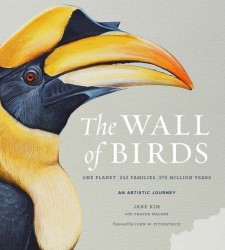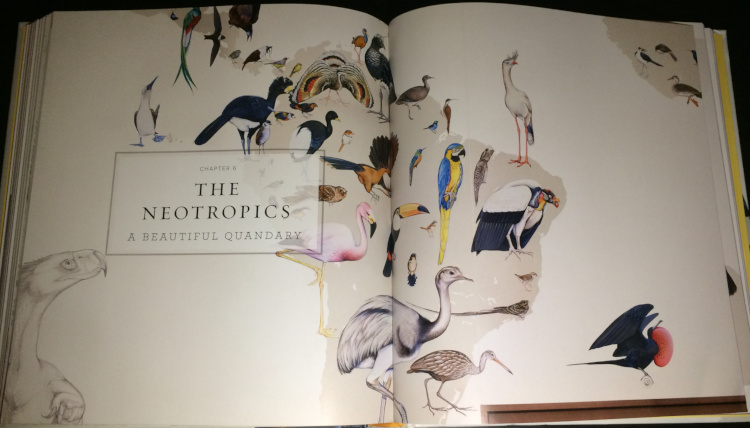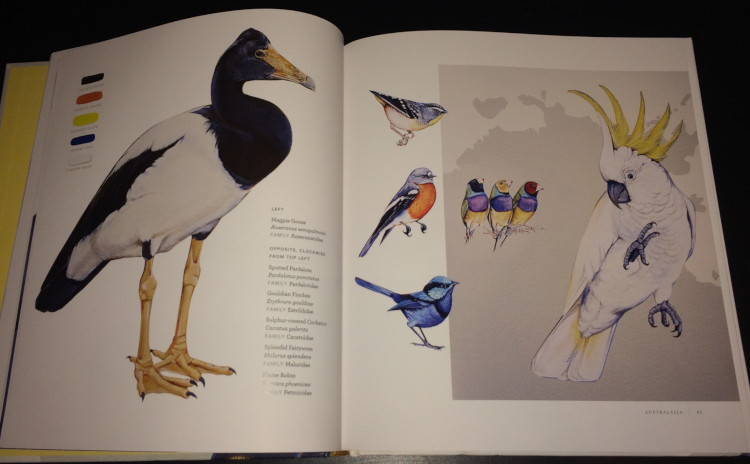Reviewed by Grant McCreary on January 24th, 2019.
Let’s say you’re a world renown organization dedicated to bird conservation and education. You have a nice, relatively new headquarters building nestled in a lovely, natural setting. But there’s one problem – a large area of blank wall space. What would you do with that? Exactly – create a huge mural featuring 243 life-size birds, one from every family. Well, that’s what the Cornell Lab of Ornithology did in their Ithaca, New York building with The Wall of Birds, or as it’s formally titled: From So Simple a Beginning: Celebrating the Evolution and Diversity of Birds .
But you don’t have to travel to Ithaca to experience this mural, painted by Jane Kim. Kim presents the birds of the mural, along with natural history information and extensive insight into its creation in a more prosaic format, a book – The Wall of Birds: One Planet, 243 Families, 375 Million Years.
The Wall is organized geographically, with the birds superimposed on an in-scale map of the world, roughly within their natural range. Likewise, the book is broken down by region. Each bird is shown at least once, though the scale may vary. Sometimes there is a cluster of birds exactly as they appear on the wall, other birds are presented singly in greater scale, some even full or larger-than-full page. Regardless of scale, each is shown in exquisite detail.
The birds are all wonderfully accurate; after all, Kim had plenty of experts looking over her shoulder as she painted! But I have to say that I am underwhelmed by the art. Overall, the paintings don’t seem very vivid, although there is great inconsistency. For example, the Wood Duck and Prothonotary Warbler on pages 190-1 really pop. But then a few pages later, other North American representatives are downright dull. I feel, however, that this is an artifact of the medium. It’s not an indictment on the artist – she painted these birds to be viewed on a wall, not reproduced on paper. It’s also not any fault of the publisher; I feel confident in stating that this is the best the art could possibly look between the covers of a book. That’s not to say that the artwork, as it appears in the book, is not worthwhile. It offers you the chance to step closer to the wall, so to speak, to see the art up close. It’s a unique perspective, but it isn’t optimal.
That becomes obvious upon unfolding the gatefold at the end of the book. On three pages you can see the entire wall in all its glory. If I was underwhelmed before, this one image wiped all that away. The genius of the wall is not in the details of each bird, but in the whole. It’s in the composition, how everything comes together perfectly and fits on the wall as if this mural had been planned out before the building’s foundation was laid (it wasn’t). It’s in the effect, how in a glance you’re overwhelmed by the amazing diversity of birds. It is spectacular.
Thankfully, in The Wall of Birds Kim gives us much more than artwork. Surprisingly, I found the words more interesting than the brush strokes. She provides insight into the design of the mural, including the selection of species and their placement on the wall. Sometimes, such a discussion leads to a tangent not directly related to the wall. In one such case, Kim mentions that she made an effort to include female birds, which morphs to a discussion of women in ornithological art.
She also talks in detail about a few certain species, such as the marvelously unique Secretarybird. But throughout the book you will find many interesting things about these birds, written in a very easy manner that is fun to read. Here’s a great example, discussing the only representatives from Antarctica, the Snowy Sheathbill and Emperor Penguin:
Due to their opportunistic eating habits, sheathbills are often stained with the bodily fluids of other animals. “He’s too clean!” the Lab’s director, John “Fitz” Fitzpatrick cried when he saw the finished painting. He was right – there’s probably never been a wild Snowy Sheathbill that looked so crisp and snowy – bit I preferred a more visually generous approach. The sheathbill casts a long eye on the penguin in case it expels a cheap meal from one end or the other. The emperor pays him no mind.
The mural celebrates not only the wonderful diversity of birds, but their evolution as well. In addition to the 243 birds from current families, Kim shows 26 extinct creatures, both birds and select ancestors, without the color that graces the extant birds. Using the space available to her brilliantly, a series of illustrations follow a handrail down a staircase as “a literal and metaphorical line of descent both connecting…fish to reptiles to, ultimately, birds.” A few more recently extinct birds are included in their rightful geographic location, such as New Zealand’s Giant Moa, providing a haunting reminder of diversity lost.
Artists will also find much of interest here. Using the Great Cormorant as an example, Kim walks through her process step-by-step, showing us the graphite study, the initial underpainting on the wall, filling in that underpainting, and finally, the finished bird. She also explains how she managed all the necessary colors:
I developed my own avian Pantone chart. Every time I had to make a new color, I’d create and name a custom mix of latex interior house paint. Some, like Flamingo Pink, were so unique I used them only once. Others proved to be more common.
She even shows examples of 53 colors she used, from Cassowary Black to Albatross Light. Only two of those 53 are stock colors! Additionally, thirteen Golden Fluid Acrylics paints were used for “finishing touches”, which are also displayed.
Recommendation
Art is contextual. As a mural, The Wall of Birds demands to be seen in person, not in the pages of a book. So where does that leave The Wall of Birds: One Planet, 243 Families, 375 Million Years? It is still well-worth having, if not strictly as an art book, then certainly to read. You will learn much about both birds and art, and the stories behind the mural and what it took to realize it are fascinating. Just don’t be surprised if you find yourself planning a trip to Ithaca, NY.
Disclosure: I get a small commission for purchases made through links in this post.
Buy from NHBS
(based in the U.K.)
Disclosure: The item reviewed here was a complementary review copy provided by the publisher. But the opinion expressed here is my own, it has not been influenced in any way.






Comment